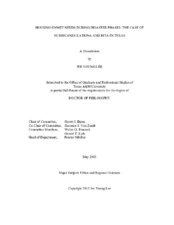| dc.description.abstract | The research aim was to examine differences in housing needs during disasters according to homeownership type by examining unmet housing needs in Texas during Hurricanes Katrina and Rita. This dissertation includes: (1) literature review regarding differences in housing needs by housing tenure normally and during disaster phases; (2) decision-making models and methods to handle incomplete tertiary data; (3) patterns of unmet housing need differing through disaster phases; and (4) factors determining likelihood of unmet housing needs for renters vs. owners before, during, and after Hurricanes Katrina–Rita. The longitudinal and logistic analyses used “real-time” reports of unmet housing needs logged in Texas’ 2-1-1 dataset covering all 254 counties during 8/1–12/31/2005.
First, previous research has shown that renters faced greater housing struggles than homeowners due to their limited resources in phases spanning from prior to a disaster to post-disaster recovery. Second, a systematic algorithm was developed to solve missing data problems in merging multiple tertiary datasets. This method would enhance opportunities to employ tertiary data for research and management studies, at the same time increasing the validity of the findings for more appropriate planning and policies. Third, in this study during Hurricanes Katrina and Rita, unmet housing needs were mostly financial issues for rental housing. The volume of unmet rental housing needs rose one week after each hurricane’s landfall compared to homeowner’s unmet needs rising in early recovery. Unmet shelter needs peaked during the immediate disaster response but extended beyond typical hurricane emergency periods. Fourth, greater affordability constraints were significantly associated with greater likelihood of rental needs prior to and during disaster emergency phases but not during recovery; however, greater affordability constraints increased the likelihood of homeowner needs only during normal phase prior to the disasters. Less availability of housing was strongly associated with greater likelihood of housing needs for both renters and homeowners. Housing quality was not associated with unmet needs when controlling for availability, affordability and disaster location. Overall, this research showed empirical evidence that policymakers need to consider developing different strategies and programs based on various types of housing needs according to homeownership type by disaster phase. | en |


